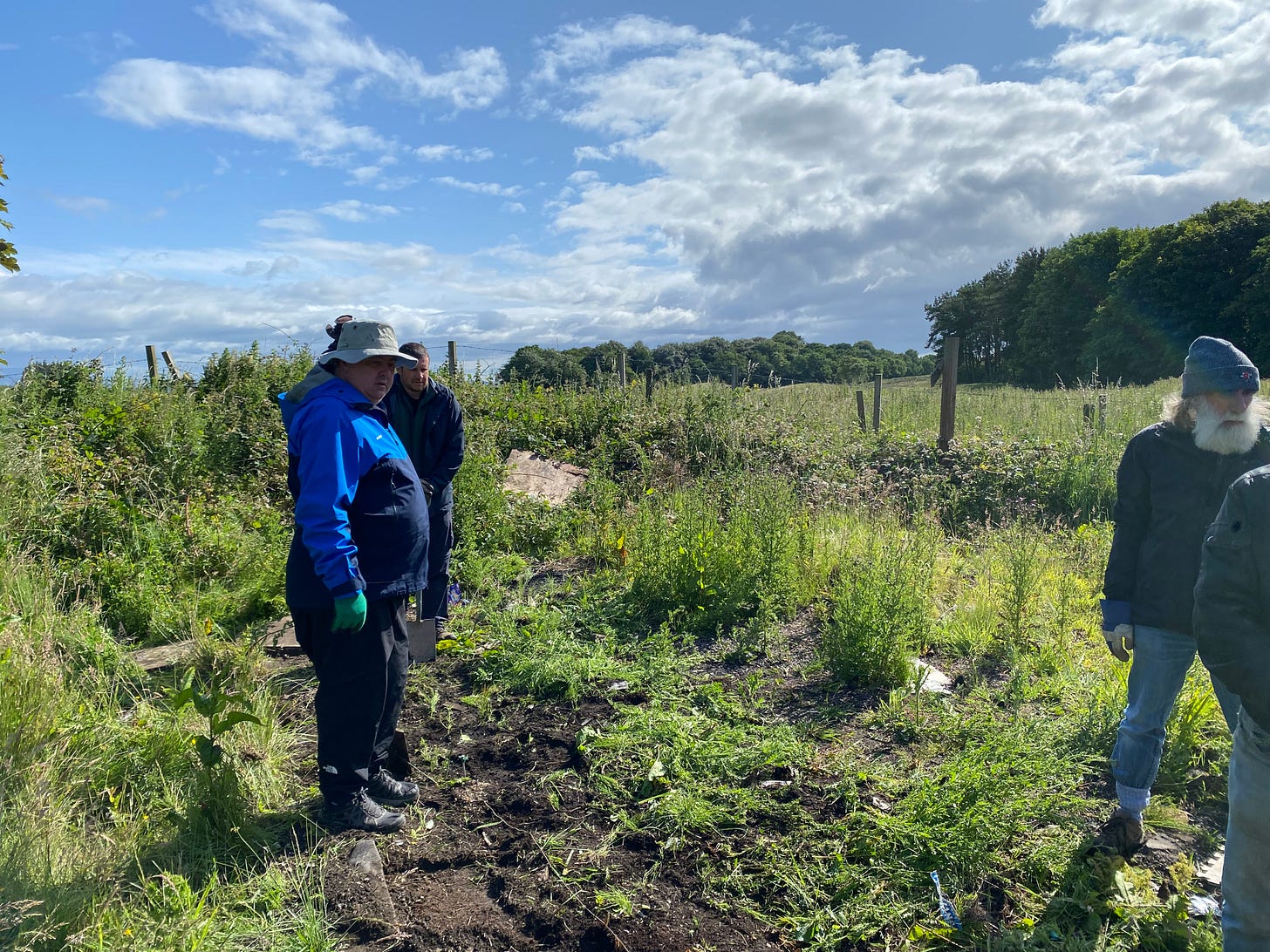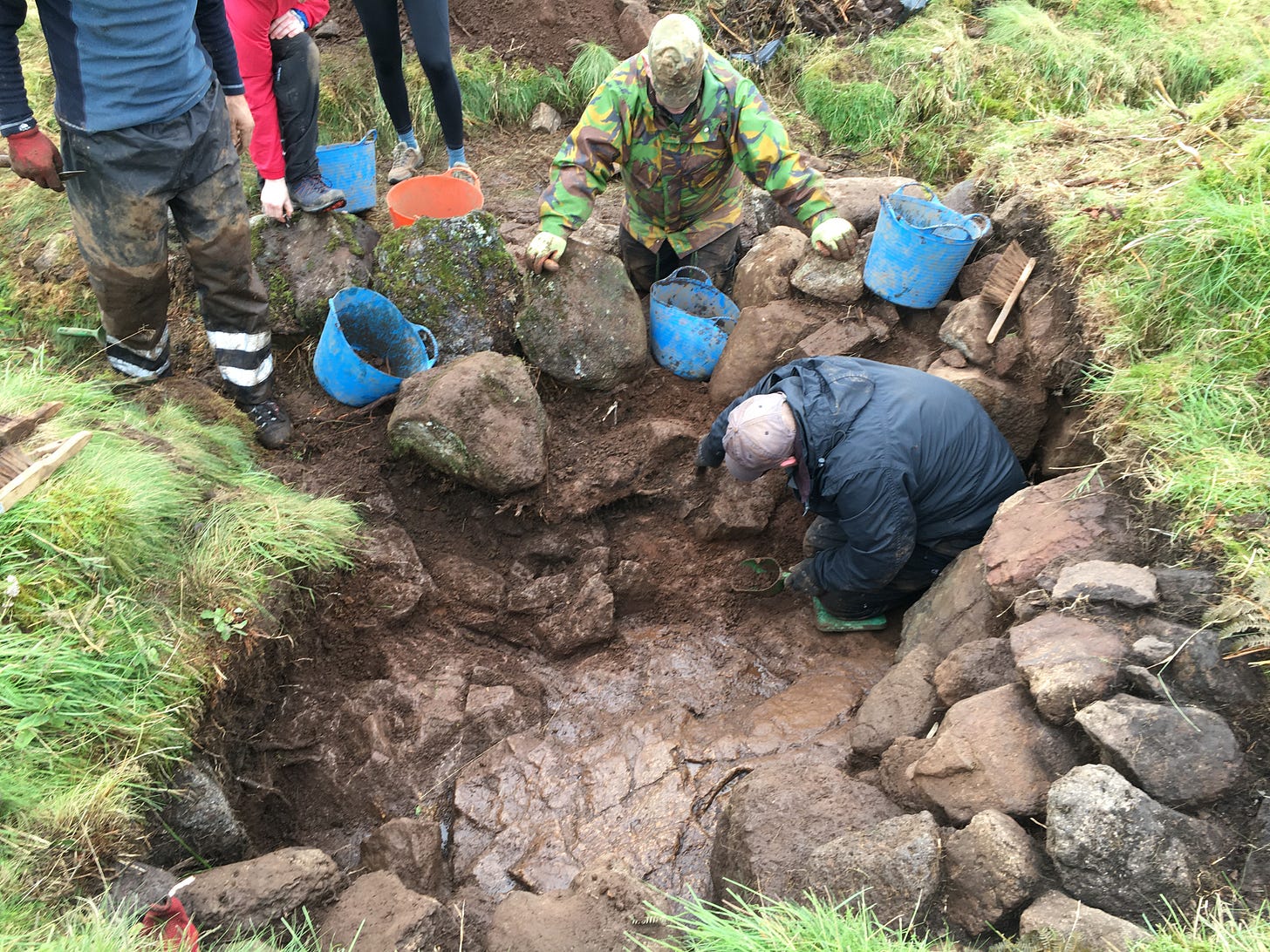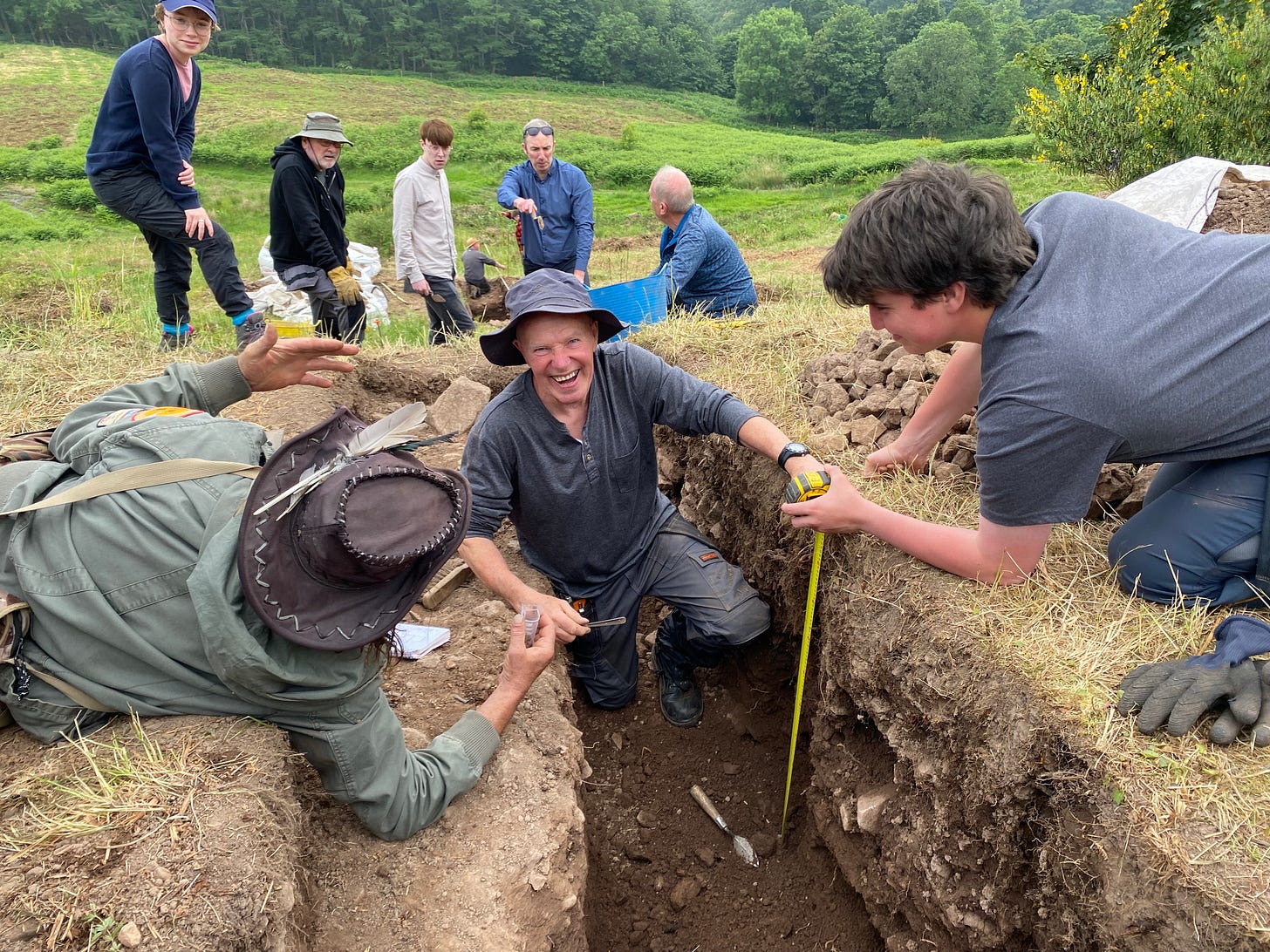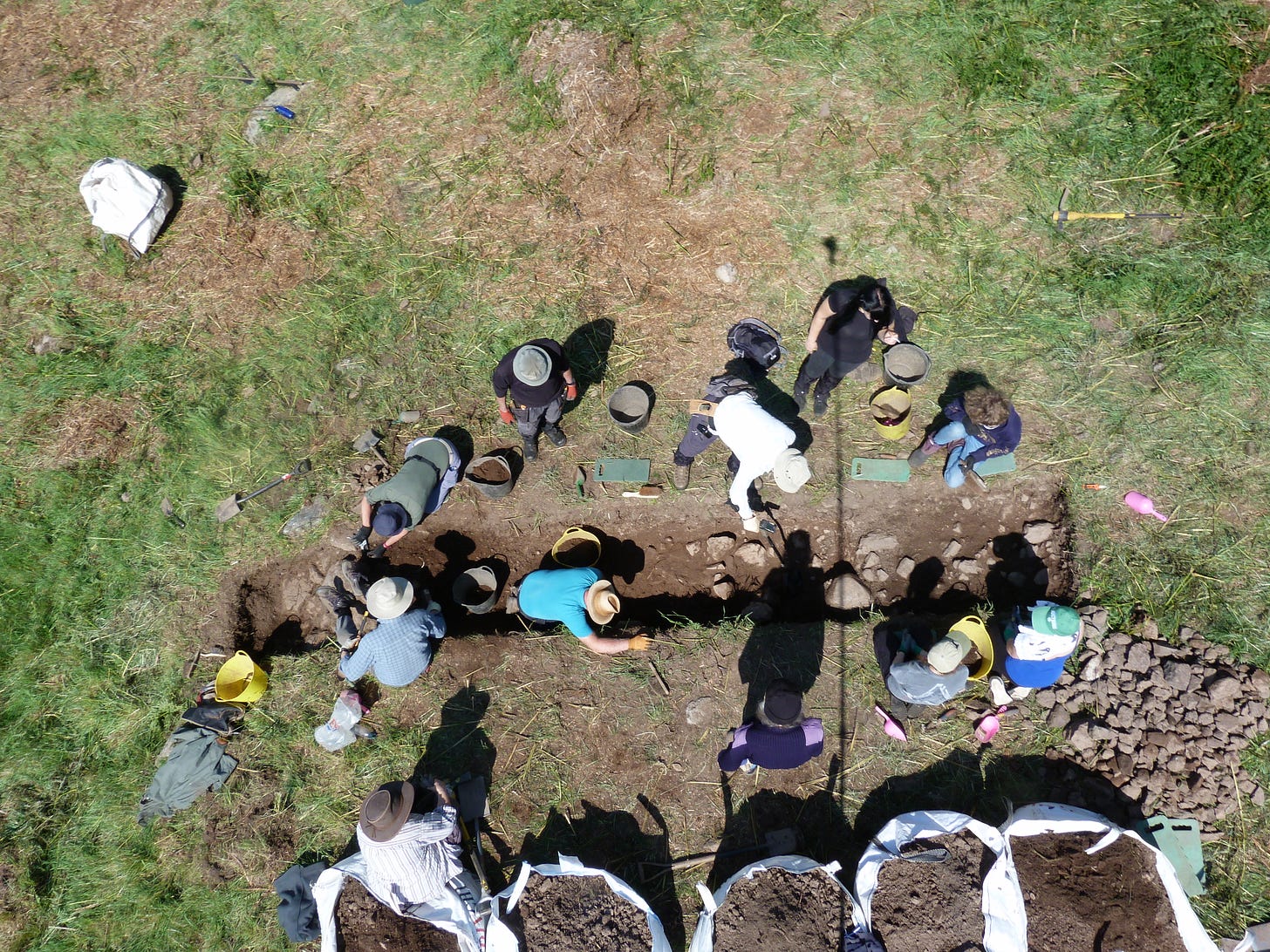How do archaeologists decide where to dig?
Site selection......where exactly should that trowel go?
Archaeologists are always asked the same questions…have you found any gold, can you dig my garden next, and have you ever found any dinosaurs? The one relevant to today’s blog is how do a we decide what to dig next.
Vollies searching for a site to dig…am sure it was there this morning!
But before the blog, weel kent faces Mike and Angie are doing a wee dig at Aberfoyle Kirk from July 21st to July 23rd. Meeting up at the Aberfoyle car park at 10 o'clock as parking is difficult at the old kirk .
There is of course the formal proper way and then what I do and of course all the various in and outs. So the ‘formal correct way’ is to start with what interests the archaeologist and then to review all we know about, start with Research Agendas (like the National Scottish One ScARF) and then read the publications and identify the gaps in the existing knowledge base. Then the next stage is to review all of the potential sites to be dug (using resources like Pastmap) and to assess which sites will best meet your research questions.
Now the first problem with the above approach is that all older research is based on contemporary mores, trends and the competence of the researcher and of course their budget, the weather etc. Round Stirling the last and indeed only major review was done in the 1950s and of course any 70 year old review of course raises problems in general. But there are also specific problems…..to take a familiar example: the Logie complex on the slopes of Dumyat which featured in last week’s blog.
A 1950s plan with lots of gaps!
So as we know this missed some of the cultivation terraces (and the term is not chronologically specific) but more complex is that it called the roundhouse a ‘homestead’ which at the time meant a substantial slightly defended house but is now a term no longer used. So it is impossible to easily research ‘homesteads’. Another wee issues is that round Stirling Stirling such substantial roundhouses date from the Middle Bronze Age (c 2000-1700 BC) to the Iron Age (c 500 BC). They are clearly not a homogenous grouping. I could extend this argument to other monument forms: ring-cairns, hillforts etc. What was a handy approach in the 1950s to gain an initial understanding is now a bit of straitjacket based on very limited data. If none of the examples in an area have been dug then our initial review becomes pointless as we have no data to review. Sometimes we don’t really know what something is till its dug and sites can jump from one classification to another: Baston Burn has been a cairn, then a broch thing then a cairn again. I started looking at because I hoped it was a broch and its definitely a cairn!
The most simple question is when does this date to….when we’ve done a reasonable sample we can get onto more complex questions but of course we have no idea what those are till we’ve got a large enough sample.
So my approach is dig first and ask questions later!
Have a question? Get in contact!
Of course if we take a monument class about which we do know lots and we can identify gaps in our knowledge base, for example brochs there is no guarantee that the landowner of the site in question will agree to allow research, assuming of course that they can be found. I’ve been refused access three times in 10 years (which of course if the owner’s right) and on two occasions I’ve not been able to find the landowner because they are represented by third parties who do not engage with me, again that’s fine. However, that means I have to turn the debate around, its not the sites that will best answer my questions, its the sites I can access. I would also argue that this removes any biases from the 1950s data, we try to dig everything so the data is more random. A case in point is that for 40 years people looked at brochs but nothing else…round Stirling we have brochs, duns and hillforts all of which are contemporary but you wouldn’t know unless you dig and for 40 years people assumed they were all chronologically distinct.
We might also think about logistics and budgets, where is the site in question that you need to answer these burning questions? Can you commute, if not how much is accommodation, is it an hour walk in or a three hour walk in. Is this practical? Can you leave tools on site or should these be carried in and out each day? What happens if the third day is a howling gale and the trenches need to be backfilled? What does the Risk assessment say and whose providing the insurance?
Then of course some sites are Scheduled Monuments and protected by the state so even if you gain landowner permission you may not necessarily gain Scheduled Monument Consent.
So assume that you have all of the permissions in place you then to find the time to dig and the budgets to deal with the reporting.
Castlehillwood Dun: a Scheduled Monument on an MOD base…multiple sets of permission that took 18 months to negotiate. The resulting reporting cost £5000.
So with our digs we lose a day at the beginning to opening and half a day at the end for backfilling and on 3-4 day project that’s a big chunk of time. People always ask why we’re stopping and why we don’t go on for longer. This of course assumes we’re being paid. To remind you, I and everyone that helps on the digs are volunteers and we all only have so much time. We could perhaps leave sites open and spend a series of days over the course of a year doing this (which we’ve done) but it presents other problems, such as health and safety and it might also interfere with the running of the land. More importantly it means that all of the costs come at the end which would really break my budget. A radiocarbon date is £400 and generally you want 5 from a site…ouch! Then the lithics that we recover are something like £30 a bit of quartz and we recovered hundreds! Now those that have followed me for a while will notice just how much we’re doing and that’s because of you and the support you send us…so thanks!
Help support Stirling Archaeology continue to provide great local content on a regular basis by becoming a paid subscriber for only £3.50 a month or £20 a year.
So my approach is different, I stick to sites within an hour’s drive of Stirling and try to do no more than an hour’s walk to site, but try not to mix these up! I will spend up to 3 years getting consent, building up confidence and reassuring the landowner we’re not going to cause problems. The trenches are small so the costs are small and so in turn is the impact on the land. In terms of where the trenches go I am always trying to hit a wall or a bank or a mound, something that can be easily characterised and has dating material in it it….remember the most important initial question is when? The more when’s we answer the easier it becomes to join the dots…are the cultivation terraces connected to Dumyat?
We try to pick the same period over a number of years at the same spot, if it suits the landowner in one year it will likely suit them the next year. We also don’t waste time getting refused permission. If we spend five years at a site the costs will be spread across each of those seasons so they are always going to be digestible. Also if we hit something too big we have a year to fund raise and plan and perhaps simply back away from it.
Another benefit to this is that people grow ever more familiar with the site in questions, their skill set and confidence grows and so in turn does the capacity of the team to do more. We are snowballing, slowly but surely getting more and more done each year. And as you will have noticed we are making a real change to not just Stirling but to Scotland. And of course you are all always welcome to come for a look or to pick up a trowel!









Thank you for sharing a lot of what is involved Murray. Well done to you and all the volunteers for amazing work.